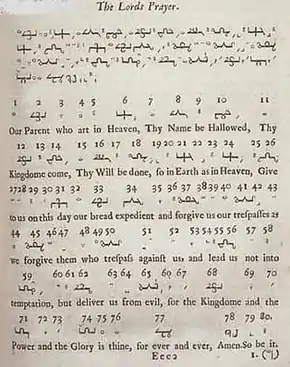

A pasigraphy (from Greek πᾶσι pasi "to all" and γράφω grapho "to write") is a writing system where each written symbol represents a concept (rather than a word or sound or series of sounds in a spoken language).
The aim is to be intelligible to persons of all languages. The term was first applied to a system proposed in 1796, though a number of pasigraphies had been devised prior to that; Leopold Einstein reviews 60 attempts at creating an international auxiliary language, the majority of the 17th–18th century projects being pasigraphies of one kind or another,[1] and several pasigraphies and auxiliary languages, including some sample texts, are also reviewed in Arika Okrent's book on constructed languages.[2] Leibniz wrote about the alphabet of human thought and Alexander von Humboldt corresponded with Peter Stephen Du Ponceau who proposed a universal phonetic alphabet.
Examples of pasigraphies include Blissymbols, Real Character, and IConji.
See also
References